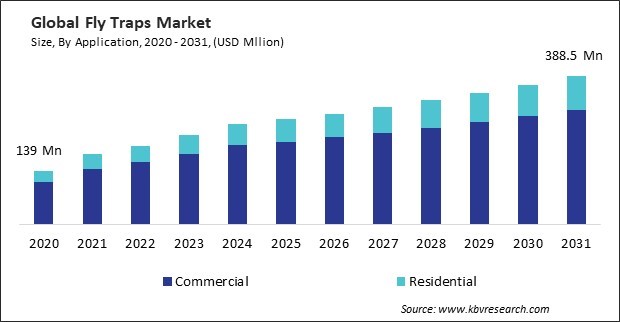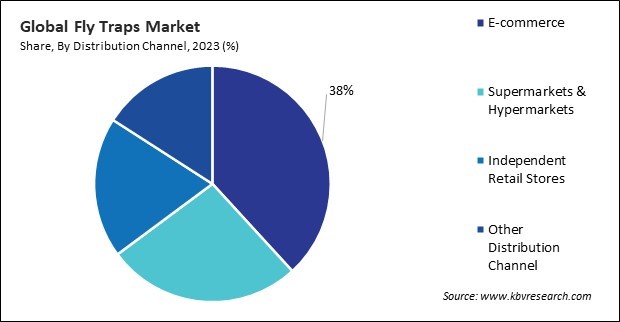“Global Fly Traps Market to reach a market value of 388.5 Million by 2031 growing at a CAGR of 5.8%”
The Global Fly Traps Market size is expected to reach $388.5 million by 2031, rising at a market growth of 5.8% CAGR during the forecast period. In the year 2023, the market attained a volume of 16,923.3 thousand units, experiencing a growth of 16.8% (2020-2023).
North America has stringent health and hygiene standards, particularly in food handling and processing industries. These are a critical component of pest control strategies to ensure compliance with these standards and prevent contamination. The increase in commercial construction projects, such as office buildings, shopping centers, and industrial facilities, creates additional demand for fly traps. These commercial spaces require pest control solutions to address fly issues related to waste management, food handling, and high foot traffic. Canadian construction sites generate significant amounts of organic waste, including food scraps from workers and materials like wood and soil that can attract flies. Thus, the North America region witnessed 48% revenue share in the fly traps market in 2023. In terms of volume, the North America region is expected to utilize 9,660.9 thousand units of fly traps by 2031.

This heightened scrutiny has driven the demand for reliable and effective fly traps to ensure compliance and avoid penalties. Public health campaigns and educational programs have raised awareness about maintaining cleanliness and the risks associated with pest infestations. Additionally, as the demand for processed foods grows, food processing facilities are expanding. These facilities, which often handle large quantities of food and ingredients, are prone to fly infestations. The need for fly traps in these environments to manage and prevent infestations is a significant driver for the market. Hence, growth in the food service and hospitality industries drives the market's growth.
However, agricultural and livestock operations generate substantial amounts of organic waste, including manure, feed, and crop residues. These waste products create ideal breeding sites for flies. The higher the volume of waste, the greater the potential for fly infestations. Consequently, there is an increased need for fly traps to manage and mitigate these infestations. In conclusion, rising agricultural activities and livestock farming are driving the market's growth.
Based on application, the market can be categorized into residential and commercial. In 2023, the residential segment acquired 21% revenue share in the market. In terms of volume 5,602.9 thousand units are expected to be utilized in residential applications by 2031. Flies are known carriers of various diseases and pathogens. Increased awareness about the health risks posed by flies, such as food poisoning, dysentery, and other infections, has led homeowners to seek effective solutions to control fly populations.
The commercial segment is further subdivided into HoReCa, factories, building management, and others. The building management segment held 21% revenue share in the market in 2023. In terms of volume, 3,728.3 thousand units of fly traps are expected to be utilized in building management applications by 2031. Building management systems integrate various building functions, such as HVAC and security, into a single platform.
By distribution channel, the market is divided into supermarkets & hypermarkets, independent retail stores, e-commerce, and others. In 2023, the e-commerce segment registered 38% revenue share in the market. In terms of volume, 9,759.7 thousand units of fly traps are expected to be sold by e-commerce by 2031. E-commerce platforms provide the convenience of shopping for fly traps anytime, allowing customers to place orders outside traditional business hours.

On the basis of price range, the market is segmented into low, medium, and high. In 2023, the high segment attained 18% revenue share in the market. In terms of volume, 4,057.3 thousand units of high-priced fly traps are expected to be utilized by 2031. High-priced fly traps often incorporate cutting-edge technology, such as advanced UV light systems, energy-efficient LEDs, and sophisticated attractants.
The container segment is further subdivided into fly light traps, fly baits, delta traps, and others. The delta trap segment attained 15% revenue share in the market in 2023. In terms of volume, 22,274.4 thousand units of delta traps are expected to be utilized by 2031. Delta traps are designed to attract flies using a combination of visual and olfactory cues.
Based on type, the market is divided into container, sticky, and electric. The electric segment garnered 44% revenue share in the market in 2023. In terms of volume, 4,057.9 thousand units of electric fly traps are expected to be utilized by 2031. Electric fly traps attract and capture flies, particularly those using ultraviolet (UV) light.
Free Valuable Insights: Global Fly Traps Market size to reach USD 388.5 Million by 2031
Region-wise, the market is analyzed across North America, Europe, Asia Pacific, and LAMEA. In 2023, the Asia Pacific region generated 20% revenue share in the market. The Asia-Pacific region is experiencing rapid urbanization, leading to increased population density and the growth of commercial and residential areas. In terms of volume the Asia pacific region is expected to utilize 9,508.3 thousand units of fly traps by 2031.
| Report Attribute | Details |
|---|---|
| Market size value in 2022 | USD 233.9 Million |
| Market size forecast in 2030 | USD 388.5 Million |
| Base Year | 2022 |
| Historical Period | 2019 to 2021 |
| Forecast Period | 2023 to 2030 |
| Revenue Growth Rate | CAGR of 5.8% from 2024 to 2031 |
| Quantitative Data | Volume in Thousand Units, Revenue in USD Million, and CAGR from 2020 to 2031 |
| Number of Pages | 559 |
| Tables | 1270 |
| Report coverage | Market Trends, Revenue Estimation and Forecast, Segmentation Analysis, Regional and Country Breakdown, Porter’s 5 Forces Analysis, Company Profiling, Companies Strategic Developments, SWOT Analysis, Winning Imperatives |
| Segments covered | Type, Price Range, Distribution Channel, Application, Region |
| Country scope |
|
| Companies Included | AGRI PHERO SOLUTIONZ, ARBICO ORGANICS, cleanrth.com, ECOTRAP GUARD, ECOMAN BIOTECH, Combined Distributors, Inc. (Flies be gone), GODWILL ENERGY PRODUCTS PVT LTD, McQwin's, Pestronics Services Pvt Ltd. and Reza Hygene |
By Application (Volume, Thousand Units, USD Million, 2020-2031)
By Type (Volume, Thousand Units, USD Million, 2020-2031)
By Price Range (Volume, Thousand Units, USD Million, 2020-2031)
By Distribution Channel (Volume, Thousand Units, USD Million, 2020-2031)
By Geography (Volume, Thousand Units, USD Million, 2020-2031)
This Market size is expected to reach $388.5 million by 2031.
Increasing awareness of hygiene and sanitation are driving the Market in coming years, however, Evolving resistance among fly populations restraints the growth of the Market.
AGRI PHERO SOLUTIONZ, ARBICO ORGANICS, cleanrth.com, ECOTRAP GUARD, ECOMAN BIOTECH, Combined Distributors, Inc. (Flies be gone), GODWILL ENERGY PRODUCTS PVT LTD, McQwin's, Pestronics Services Pvt Ltd. and Reza Hygene
In the year 2023, the market attained a volume of 16,923.3 thousand units, experiencing a growth of 16.8% (2020-2023).
The Commercial segment is leading the Market by Application in 2023; thereby, achieving a market value of $300.1million by 2031.
The North America region dominated the Market by Region in 2023, and would continue to be a dominant market till 2031; thereby, achieving a market value of $180.5 million by 2031.
Our team of dedicated experts can provide you with attractive expansion opportunities for your business.

 Drivers
Drivers
 Restraints
Restraints
 Opportunities
Opportunities
 Challenges
Challenges
